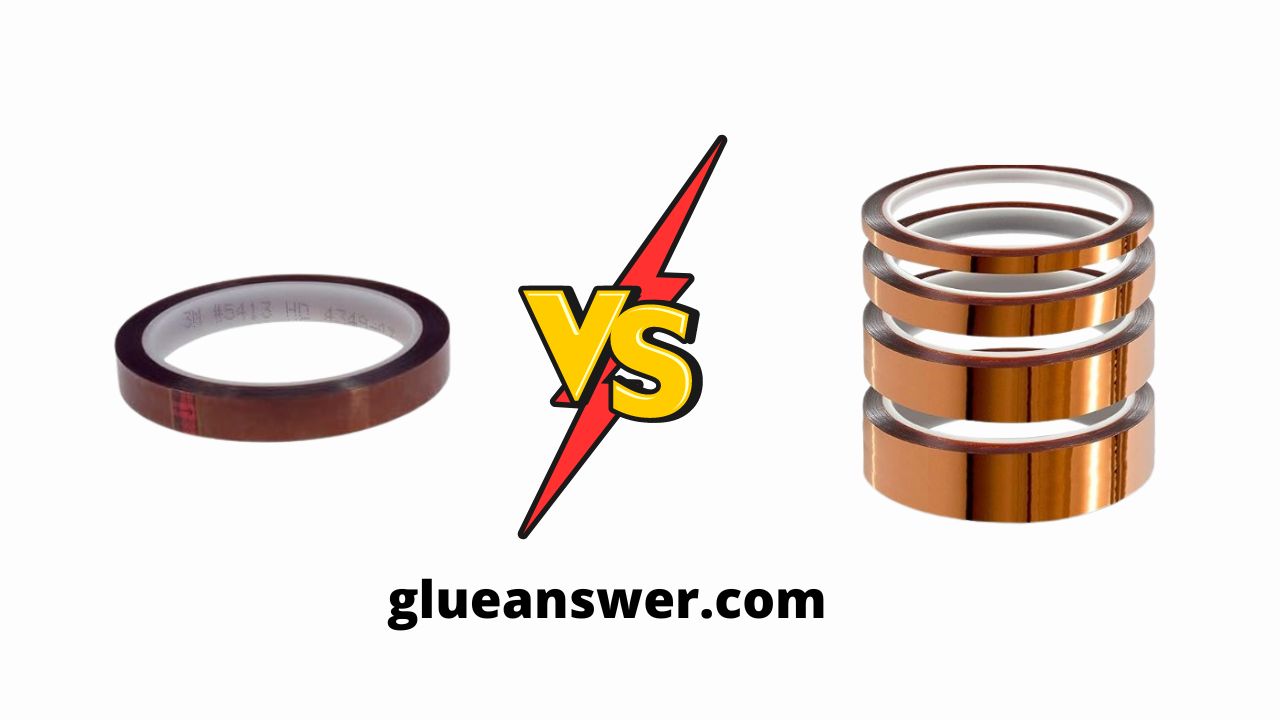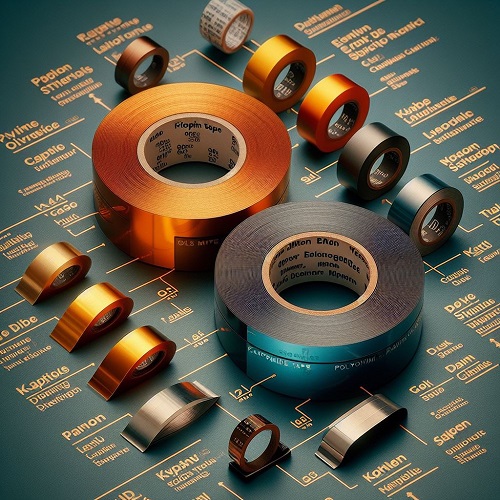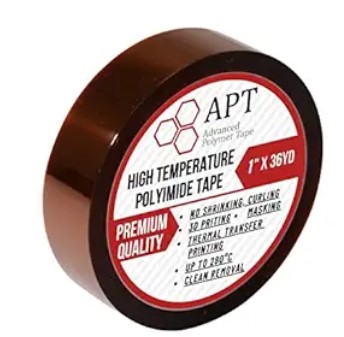Polyimide Tape Vs Kapton Tape: The Battle of Insulating Tapes

Polyimide tape and Kapton tape are often used interchangeably as they are closely related, with Kapton being a brand name for polyimide tape. Here are some differences that may help clarify their relationship:
Polyimide Tape vs. Kapton Tape: Understanding the Similarities and Differences
While often used interchangeably, polyimide tape and Kapton tape aren’t exactly the same thing. Here’s a breakdown of their key differences:
1. Material:
- Polyimide Tape: This is the generic term for any tape made from polyimide film, a highly heat-resistant polymer. It can be manufactured by various brands.
- Kapton Tape: This is a specific brand of polyimide tape created by DuPont. It’s known for its consistent quality and performance.
2. Other Differences:
- Adhesive: Both use high-temperature adhesives, but specific types and strengths might differ based on the manufacturer and desired application.
- Availability: Kapton tape is widely available, while specific polyimide tapes from other brands might have limited availability.
- Price: Kapton tape can sometimes be more expensive than generic polyimide tapes.
3. Similarities:
- Both offer excellent thermal stability: They can withstand high temperatures (up to 500°C for Kapton) without melting or degrading.
- Both have strong electrical insulation properties: They are ideal for electrical applications like transformers and motors.
- Both are chemically resistant: They can withstand exposure to many chemicals and solvents.
Polyimide adhesive tape used in electronics, aerospace, and industrial applications. High-temperature Kapton Tape, commonly used in electronics insulation and aerospace.
However, there are some other differences between these two tapes. We will explore everything in this polyimide tape vs kapton tape battle.
Polyimide Tape Vs Kapton Tape: Main Differences
Here’s a breakdown:
| Feature | Polyimide Tape | Kapton Tape |
| Quality | Quality can vary depending on manufacturer | Known for consistent high quality |
| Temperature Range | Up to -196 to +400°C | Up to -269°C (-452°F) to 400°C (752°F) |
| Thickness | 0.06 mm | 1 mil (0.03mm) |
| Color | Typically amber or brown | Typically amber or brown |
| Strength | about 200 kPa | 200 kPa 350kPa |

Is Polyimide Tape Same As Kapton Tape?
No, though often used interchangeably, they’re not the same. Polyimide is a generic term for the film, while Kapton is a specific brand name by DuPont.
Kapton generally has higher temperature resistance and a specific silicone adhesive, while polyimide tape can have various adhesives and lower cost.
What Is Polyimide Film Tape Used For?
- Polyimide film tape is heat-resistant and flame-retardant.
- Widely used in electronics for insulation purposes.
- Commonly used in the aerospace industry for wire and cable wrapping.
- Provides excellent electrical insulation.
- Resistant to chemicals and solvents.
- Suitable for high-temperature applications, such as masking during soldering.
- Offers dimensional stability and durability.
What Are The Properties Of Polyimide Film?
- High Temperature Resistance: Can withstand extreme temperatures.
- Chemical Resistance: Resistant to chemicals and solvents.
- Excellent Electrical Insulation: Used in electronic applications.
- Low Coefficient of Thermal Expansion: Dimensionally stable.
- Mechanical Strength: Provides durability.
- Flexibility: Maintains flexibility even at high temperatures.
- Low Outgassing: Suitable for vacuum environments.
- Good Dielectric Properties: Useful in insulating applications.
1. 3M 5413 Polyimide Film Tape
Conquer extreme temperatures with the reliable performance of 3M™ Polyimide Tape 5413. This premium tape boasts a unique combination of high-temperature resistance, superior release properties, and dimensional stability.

Features
- Durable polyimide film: Withstands continuous temperatures up to 500°F (260°C) and short-term spikes even higher, ensuring performance in harsh environments.
- Silicone adhesive: Offers excellent high-temperature performance and clean release, preventing residue upon removal.
- Dimensionally stable: Maintains its shape and size at elevated temperatures, preventing rework and ensuring precise results.
- Flame retardant and chemical resistant: Provides added safety and protection in demanding industrial settings.
- Flexible and conformable: Adheres easily to irregular surfaces for versatile applications.
- Available in various widths and lengths: Choose the size that best suits your project needs.
Pros
- Ideal for applications like soldering, masking, and circuit board protection.
- Leaves no residue, simplifying removal and cleanup.
- Withstands demanding environments and ensures long-lasting performance.
- Suitable for various applications across different industries.
Cons
- Higher cost compared to some standard tapes.
- Silicone adhesive may not be suitable for all bonding applications.
Read More About Choosing the Best: Wood Glue vs Epoxy for Strong and Durable Bonds
How Thick Is 3M 5413?
The thickness of 3M 5413 tape is 2.7 mil, which means it is 2.7 thousandths of an inch thick.
Polyimide Tape Vs Kapton Tape Vs Electrical Tape
| Feature | Polyimide Tape | Kapton Tape | Electrical Tape |
| Material | Polyimide film | Polyimide film | PVC (vinyl) or rubber |
| Adhesive | Varies (acrylic, silicone, pressure-sensitive) | Primarily silicone | Rubber or acrylic |
| Temperature Range | Up to -196 to +400°C | Up to -269°C (-452°F) to 400°C (752°F) | 200°F (93°C) |
| Electrical Insulation | Good | Excellent | Good |
| Flame Retardancy | Varies | Yes | Varies |
| Moisture Resistance | Good | Excellent | Varies |
| Chemical Resistance | Good | Excellent | Varies |
| Strength | Moderate | High | Moderate |
| Flexibility | High | High | Moderate |
Polyimide Tape Vs Kapton Tape For Metal
Both excel for metal applications, but with nuances: Polyimide tape: generally cheaper, good for moderate heat & basic insulation. Kapton tape: pricier, handles higher heat, excellent electrical insulation & chemical resistance.
Polyimide Tape Temperature Rating
Polyimide tape has a wide temperature range, with a low limit of -269°C (-452°F) and a high limit of 260°C (500°F). This makes it suitable for various applications with extreme temperature conditions.
Is Polyimide Heat Resistant?
Yes, polyimide is known for its excellent heat resistance. It can withstand continuous temperatures up to 400°C (752°F) and short-term spikes even higher.
What Are The Disadvantages Of Polyimide?
- Cost: Polyimide materials can be expensive.
- Processing Difficulty: Manufacturing polyimide can be complex and requires specialized equipment.
- Brittleness: Polyimides can be brittle at low temperatures.
- Moisture Absorption: They may absorb moisture, affecting performance.
- Limited Color Options: Limited color choices compared to other polymers.
- Environmental Impact: Some formulations may have environmental concerns.
What Is The Maximum Temperature For Polyimide Tape?
Polyimide tape itself can withstand up to 400°C (752°F), but the maximum temperature depends on the specific type and its adhesive.
What Is Another Name For Polyimide?
Another name for polyimide is PI film, though technically it’s not the same as the tape itself. For tape specifically, Kapton is a widely used brand name, but not a universal term.
Why Use Polyimide?
Polyimide shines in high-heat situations! Its key advantages are: excellent temperature resistance, strong electrical insulation, chemical resistance, and flexibility. Think circuit boards, aerospace, and demanding industrial applications.
What Is Polyimide Tape Made Of?
Polyimide tape is made from a durable plastic called polyimide, known for its exceptional heat resistance, electrical insulation, and chemical resistance.
What Is The Difference Between Polyimide And Pet Tape?
The key difference lies in material: polyimide offers extreme heat resistance (up to 500°C) and superior electrical insulation, while PET (polyethylene terephthalate) tape handles lower temperatures (around 220°C) and excels in general-purpose applications.
Kapton Tape
Kapton tape is a type of polyimide film tape known for its exceptional high-temperature resistance, electrical insulation, and chemical resistance.
What Is Kapton Made Of?
It’s made from DuPont’s proprietary Kapton polyimide film and typically has a silicone adhesive.
2. MYJOR High Temperature Kapton Tape
This 1 mil thick Kapton tape, also known as high-temperature polyimide tape, offers a reliable shield for your delicate electronics when the heat is on. Perfect for professionals and hobbyists alike, it boasts impressive features and versatility.

Features
- Ultra-Thin Design: At just 1 mil thick, this tape provides maximum thermal protection without adding bulk.
- Exceptional Heat Resistance: Withstands continuous temperatures up to 500°F (260°C) and even higher for short bursts, making it ideal for soldering, masking, and high-temperature applications.
- Reliable Protection: Guards your CPU, PCB circuit boards, and other sensitive components from heat damage, ensuring their optimal performance and lifespan.
- Clean Release: Leaves no residue upon removal, simplifying cleanup and preventing damage to delicate surfaces.
- Versatile Sizes: Available in various widths (1/4″, 1/2″, 3/4″, 1″) to suit your specific needs and projects.
Pros
- Ideal for demanding tasks like soldering and PCB assembly.
- Conforms easily to uneven surfaces for precise application.
- Makes cleanup quick and hassle-free.
- Offers options for various projects and component protection.
- Provides excellent value for its performance and versatility.
Cons
- Not as strong as some thicker tapes
- Limited chemical resistance
Double Sided Kapton Tape
This double-sided Kapton tape combines the exceptional high-temperature resistance (up to 500°F) of Kapton with the convenience of double-sided bonding.
3. APT Advanced Polymer Tape 3D Printer Kapton Tape
This high-temperature and heat-resistant tape are engineered to meet the demands of precision tasks in demanding environments. With a size of 1″ x 36 yds, this tape provides ample length for multiple projects, ensuring efficiency and convenience.

Features
- High-Temperature Resistance: Our Polyimide Adhesive Tape can withstand elevated temperatures.
- Precision and Flexibility: With a thickness of 1 mil, this tape offers excellent flexibility and conformability, allowing it to adhere seamlessly to various surfaces.
- Electrical Insulation: The tape provides reliable electrical insulation. It helps protect components from short circuits and other electrical hazards.
- 3D Printer Compatibility: Tailored for 3D printing applications, this tape assists in creating clean and precise prints.
- Durable Adhesive: The adhesive backing ensures a strong and durable bond, keeping the tape securely in place during use.
Pros
- Suitable for a wide range of applications.
- Withstands high temperatures.
- Generous 36 yards of tape ensures that you have an ample supply for multiple projects.
- Thin 1 mil thickness allows for precise application and masking in intricate work.
- Enhances safety by providing effective electrical insulation in various applications.
Cons
- The high-performance features may come with a slightly higher cost compared to standard tapes.
Read Also Wood Glue Vs Liquid Nails: Choosing the Right Adhesive for Woodworking
What Is Kapton Tape Used For 3d Printing?
- Heat Resistance: Withstands high temperatures during 3D printing.
- Bed Adhesion: Helps prints adhere to the build surface.
- Insulation: Protects against heat transfer to other parts of the printer.
- Electrical Insulation: Prevents electrical contact and short circuits.
- Chemical Resistance: Resistant to various chemicals, ensuring durability.
Kapton Tape Usage- Kapton Tape Application
- Electrical insulation: Kapton tape is widely used for wrapping and insulating electrical components.
- Circuit board protection: It provides a heat-resistant and reliable cover for circuit boards.
- Aerospace applications: Kapton tape is used in spacecraft and aviation for its thermal stability.
Is Kapton Tape Electrically Conductive?
Kapton tape itself isn’t electrically conductive. However, there are specific types of Kapton tape with conductive carbon layers or other additives specifically designed for electrical applications like anti-static control or EMI shielding.
What Are The Disadvantages Of Kapton?
- Expensive: Kapton is a high-cost material.
- Brittle: Kapton can become brittle at low temperatures.
- Limited color options: Typically available in brownish-yellow color.
- Sensitivity to certain chemicals.
- Difficult to recycle.
- Limited flexibility compared to some other polymers.
- Susceptible to punctures and tears.
Kapton Polyimide Tape
Kapton Polyimide Tape is a high-temperature-resistant adhesive tape commonly used in electronics and aerospace applications. Its polyimide film provides excellent thermal stability, electrical insulation, and chemical resistance.
Kapton Tape Vs Electrical Tape
Here’s a breakdown to help you choose the right one:
| Feature | Kapton Tape | Electrical Tape |
| Material | Polyimide film | PVC (vinyl) or rubber |
| Temperature Range | -269°C to 400°C | 0°F to 221°F |
| Electrical Insulation | Excellent | Good |
| Flame Retardancy | Yes | Some varieties |
| Moisture Resistance | Excellent | Varies |
| Chemical Resistance | Excellent | Varies |
| Flexibility | High | Moderate |
Kapton Tape Temperature
Kapton tape is known for its temperature resistance, capable of withstanding extreme conditions. It can endure temperatures as low as -452°F and as high as 752°F.
Kapton Max Temperature
Kapton, a polyimide film, has a maximum temperature resistance of 752°F (400°C).
Kapton Tape Melting Temperature
Kapton tape has a melting temperature range of 375 to 401 °C.
What Is Better Than Kapton Tape?
Determining “better” depends on your needs. For extreme temperature resistance and electrical insulation, Kapton excels. For everyday electrical use and affordability, consider electrical tape.
What Is The Difference Between Electrical Tape And Kapton Tape?
The key difference lies in temperature resistance:
- Electrical tape: Handles up to 0°F to 221°F, ideal for basic electrical insulation and temporary repairs.
- Kapton tape: Withstands scorching temperatures up to -269°C to 400°C, perfect for soldering, masking in high-heat applications, and demanding environments.
What Is Equivalent To Kapton Tape?
- Polyimide tape: Similar material, but lower temperature rating and potential variations in adhesive & properties.
- High-temperature fiberglass tape: Good heat resistance (around 260°C), but less flexible and electrically insulating.
- Silicone tape: Offers high heat resistance and flexibility, but electrical properties not as strong as Kapton.
How Thick Is 3m Scotch Tape?
3M Scotch Tape thickness varies depending on the specific type and purpose. Standard transparent household Scotch Tape (600) is typically 2.3 mil (0.058 mm) thick.
What Is The Thickness Of 3m Mirror Tape?
The thickness of 3M mirror tape is 0.0625 inches, which is equivalent to 1.6mm.
How Thick Is 3m Molding Tape?
3M Molding Tape with a thickness of 0.045 inches is equivalent to 45 mil (thousandths of an inch). The tape is commonly used for bonding automotive trim and molding.
How Thick Is 3m Electrical Tape?
3M electrical tape with a thickness of 6 mils (0.15mm) provides reliable insulation for electrical wires and components. This tape is commonly used for splicing, insulating, and bundling applications in various electrical systems.
How Thick Is 3m 92 Tape?
The 3M 92 tape is 2.75 mils thick, which is equivalent to 0.070 mm. The thickness is commonly measured in mils (thousandths of an inch) or millimeters.
FAQs
Is polyimide a PTFE?
No, polyimide and PTFE are different materials, though both offer valuable properties. Polyimide excels in high-temperature resistance and electrical insulation, while PTFE prioritizes low friction and chemical resistance.
Why is Kapton tape so expensive?
Kapton tape boasts several features that contribute to its higher cost compared to electrical tape:
- High-performance materials
- Specialized manufacturing
- Diverse applications
- Brand recognition
What is the difference between Kapton tape and normal tape?
The key difference lies in temperature resistance: Kapton tape withstands extreme heat (up to 500°C) while “normal” tape (e.g., electrical tape) melts at much lower temperatures.
Is polyimide tape electrically conductive?
Standard polyimide tape is not electrically conductive. However, some specialized types of polyimide tape are made with conductive additives, like carbon particles.
What is an alternative to Kapton?
Alternatives to Kapton depend on your specific needs. Polyimide tape offers similar high-temp resistance at a lower cost.
What is the color of polyimide?
While some newer colorless options exist, most polyimides are orange/yellow due to the inherent properties of their chemical structure.
Is polyimide amorphous or crystalline?
Polyimide can be both amorphous and crystalline, depending on processing conditions. Generally, it’s amorphous in injection molding or extrusion, but crystallization can occur through annealing or specific solvent treatments.
Conclusion
The comparison between polyimide tape vs Kapton tape reveals distinctions in quality, temperature range, and adhesive properties.
In essence, while polyimide tape is a broad term, Kapton tape specifically refers to polyimide tape manufactured by DuPont. When comparing the two, it’s essential to consider specific requirements, brand preferences, and budget constraints.
While both serve in electronics and aerospace, Kapton stands out with consistent high quality and a broader temperature range.
The choice depends on specific application needs, considering factors such as cost, temperature resistance, and electrical insulation.






